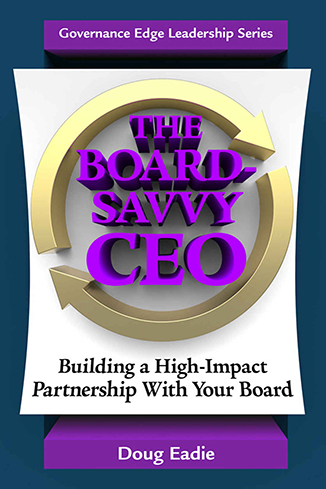 My most recent article at this blog, “Board Composition as a Conscious Growth Tool,” shared some really good news. The governance committee of a prestigious aging services nonprofit used the process of filling board vacancies to turn the 25-member board into a more powerful vehicle for achieving the nonprofit’s growth targets. Over the course of three hours or so, committee members had brainstormed candidates for board seats whose connections, experience, expertise and other qualifications might help this nonprofit grow. And putting the cherry on the sundae, they followed through by actively recruiting these candidates.
My most recent article at this blog, “Board Composition as a Conscious Growth Tool,” shared some really good news. The governance committee of a prestigious aging services nonprofit used the process of filling board vacancies to turn the 25-member board into a more powerful vehicle for achieving the nonprofit’s growth targets. Over the course of three hours or so, committee members had brainstormed candidates for board seats whose connections, experience, expertise and other qualifications might help this nonprofit grow. And putting the cherry on the sundae, they followed through by actively recruiting these candidates.
What I didn’t share in that article was some bad news. The governance committee had held a meeting a couple of months earlier to design the brainstorming session I’ve described. About half-way through that earlier meeting, a loyal, long-tenured board member – who was passionately committed to the nonprofit’s mission and had always done more than his share of work on the board’s external relations committee – came close to derailing the critical process of beefing up the board’s composition. He didn’t do it by ranting and raving. Rather, very calmly, without any obvious negative emotion, he suggested that the governance committee was going in entirely the wrong direction. Instead of spending precious time going after new talent on the board, he said, what the governance committee really needed to do was push for reducing the board’s size to, say, 15 members. I recall his saying that while “diversity sounds really good in theory,” what the nonprofit really needed was a “more manageable” board that could get its work done more efficiently. Fortunately, the other committee members stuck to their guns, agreeing to move ahead with the planned brainstorming session, but if this very influential naysayer had persisted, he might very well have carried the day.
I honestly was dumbstruck at the tack this otherwise very rational and productive board member took. To argue for downsizing in the face of the patently obvious need for a richer reservoir of resources on the board to draw on in such challenging times didn’t make sense. But as I mulled over what’d happened that evening, I realized that the culprit that had nearly derailed the effort was that familiar – and insidious – enemy of positive change: fear. Of what? Of displacement, of being out-shown by new board members bringing new resources. Why insidious? The American Heritage Dictionary (Second College Edition) defines “insidious” as “working or spreading harmfully in a subtle or stealthy manner.” This narrow-minded naysayer had almost carried the day in making the case for a less diverse board – not by screaming, but by calmly – insidiously – offering what sounded like sensible advice. And, I’d venture to guess, what made his wrong-headed counsel even more insidious was the fact that he was probably totally unaware of being fearful. He had fallen victim to another common enemy of positive change: self-deception.
Alas, on the never-ending organizational development journey, fear and change are almost always close traveling companions, with self-deception along for the ride. We can anticipate and blunt the impact of fear and self-deception, but I doubt that we’ll ever be able to eradicate it. I’d love to hear our readers’ experience in combating these insidious foes of positive change.





